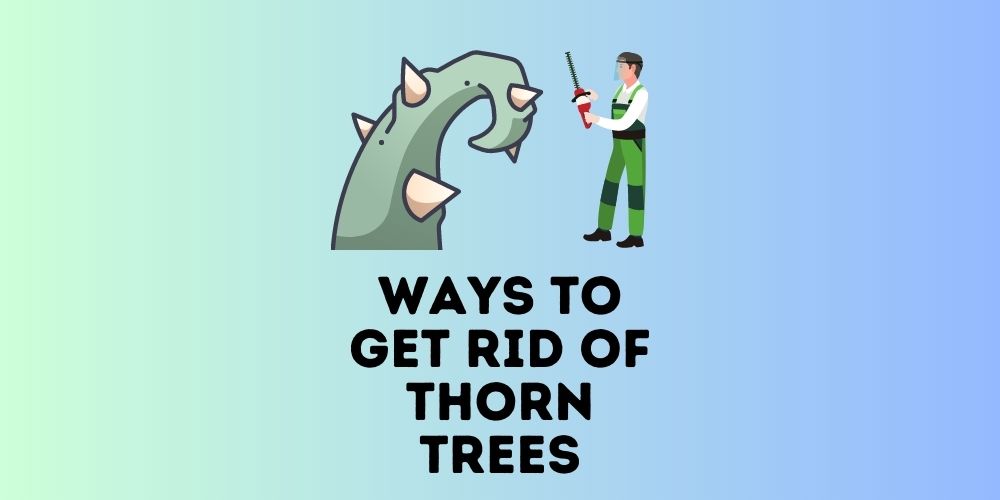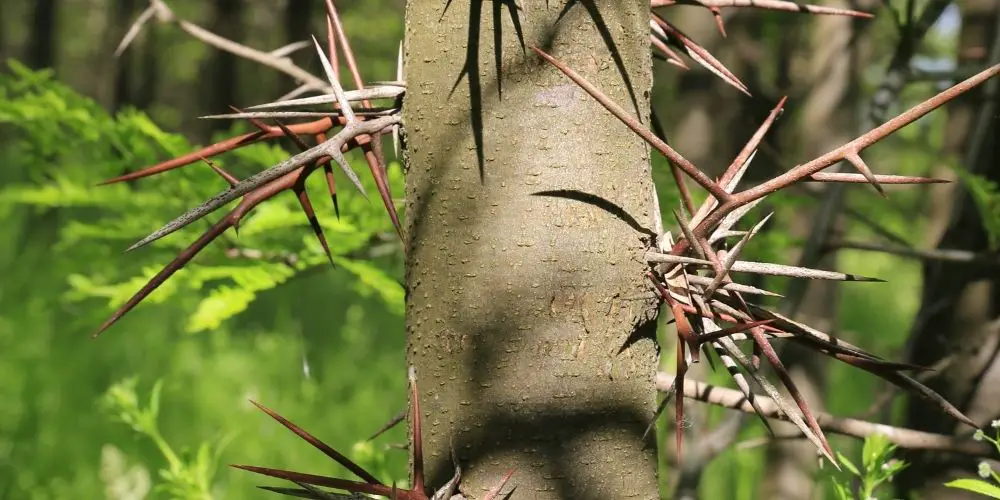
Thorn trees, also known as thorny bushes, are known for their sharp and prickly thorns that can be hazardous to people and animals alike. These trees can cause injury, make it difficult to access certain areas, and even damage property. Removing thorn trees can be challenging, as they often have deep and extensive root systems. In this response, we will explore some effective ways to eliminate thorn trees.
Various Types of Thorn Trees and Bushes
There are various types of thorn trees and bushes that grow in different regions of the world. Here are some examples:
Acacia: Acacias are thorn trees that are native to Africa and Australia. They are known for their yellow flowers and their long, sharp thorns.
Blackthorn: Blackthorn is a bush that is native to Europe and Asia. It is known for its dense, spiny branches and its small, purple fruits.
Hawthorn: Hawthorn is a small tree or shrub that is native to Europe, North Africa, and western Asia. It has sharp thorns and produces clusters of white or pink flowers in the spring.
Mesquite: Mesquite is a thorny tree that grows in the southwestern United States, Mexico, and South America. It has long, sharp thorns and produces small, yellow flowers.
Osage orange: The Osage orange is a thorny tree that is native to the central and eastern United States. It has large, green fruits and sharp thorns that can grow up to 4 inches long.
Prickly pear cactus: The prickly pear cactus is a type of cactus that is native to North and South America. It has thick, spiny pads and produces bright, colorful fruits.
Rose bush: The rose bush is a thorny shrub that is native to Europe, Asia, and North America. It produces beautiful flowers in a wide range of colors and is often used in gardens and landscaping.
Russian olive: The Russian olive is a small tree that is native to Asia and Europe but has been introduced to many parts of the world, including North America. It has silvery leaves and sharp thorns and produces small, yellow fruits.
Spanish Dagger: Spanish Dagger, also known as Yucca gloriosa, is a flowering plant that belongs to the Asparagaceae family. It is native to the southeastern United States and produces tall spikes of white or yellow flowers. The plant has long, sword-like leaves with sharp tips.
Gorse: Gorse is a bush that is native to Europe and parts of Asia. It has dense, spiny branches and produces bright yellow flowers. It is often considered a weed in many parts of the world due to its aggressive growth and ability to outcompete native plants.
Devil’s Club: Devil’s Club, also known as Oplopanax horridus, is a large shrub that is native to western North America. It has sharp thorns and produces clusters of red berries. The plant is traditionally used by Indigenous peoples for medicinal purposes.
Wait-a-minute bush: Wait-a-minute bush, also known as Acacia farnesiana, is a thorny shrub that is native to North and South America. It has fragrant yellow flowers and sharp, curved thorns that can easily catch on clothing.
Wild plum: Wild plum, also known as Prunus americana, is a small tree or shrub that is native to North America. It produces small, tart plums and has thorny branches.
Honey locust: Honey locust is a tree that is native to eastern North America. It has long, sharp thorns and produces clusters of fragrant flowers in the spring
8 Methods to get rid of thorn trees:
- Hand pulling: For small thorn trees, hand pulling can be effective. The best time to hand-pull a thorn tree is when the soil is moist, making it easier to remove the tree with its roots intact.
- Dig out the roots: Another method is to dig out the roots of the tree. This method is useful for smaller trees. Use a shovel to dig around the tree, and then pull out the roots. This may require some effort, but it can be an effective way to remove the tree.
- Chemical control: Herbicides such as glyphosate can be used to kill thorn trees. These chemicals are applied to the leaves of the tree, where they are absorbed and eventually kill the tree.
- Use a Tree injection: Tree injections involve injecting a chemical directly into the trunk of a thorn tree. The chemical will kill the tree over time, but it may take several months to see results.
- Mechanical control: Mechanical control methods such as mowing, pruning, and cutting can be effective for removing thorn trees. However, these methods are often temporary, and the thorn trees can regrow quickly.
- Natural remedies: There are several natural remedies that can be used to get rid of thorn trees, such as vinegar, salt, and boiling water. These methods may not be as effective as chemical treatments, but they are safer and more environmentally friendly.
- Burn the tree: Burning a thorn tree is not recommended, but it can be effective in some situations. Make sure to follow fire safety precautions and obtain any necessary permits before burning a tree.
- Professional tree removal: For larger thorn trees or those that are deeply rooted, it may be necessary to hire a professional tree removal service. These professionals have the equipment and expertise to remove thorn trees safely.
How to Cut Down a Thorn Tree?
Cutting down a thorn tree can be a challenging task due to the tree’s thorns and deep root system. Here are some steps to follow to cut down a thorn tree safely and effectively:
- Assess the tree: Before cutting down the tree, assess its size, location, and the direction it will fall. Make sure there are no obstacles in the way and that you have a clear escape route.
- Wear protective gear: Wear thick gloves, long sleeves, and pants to protect yourself from the thorns on the tree.
- Cut off the branches: Using a pruning saw or chainsaw, start by cutting off the branches of the tree. Cut the branches into manageable sections and remove them from the area.
- Cut the trunk: Once the branches are removed, cut the trunk of the tree at the base. Make a horizontal cut on the side of the tree where you want it to fall, and then make a diagonal cut above it on the opposite side. This will create a wedge that will guide the tree in the desired direction.
- Retreat to a safe distance: After making the cut, retreat to a safe distance and let the tree fall.
- Remove the stump: If you want to remove the stump, use a stump grinder or hire a professional tree removal service.
Remember, cutting down a tree can be dangerous, and it is important to take the necessary precautions to protect yourself and others.

Best Chemical To Kill Honey Locust
The most effective chemical to kill honey locust trees is a systemic herbicide containing glyphosate, triclopyr, or imazapyr. These herbicides are absorbed by the tree’s leaves and transported throughout the tree, including the roots, where they interfere with the tree’s ability to produce energy and eventually kill it.
Glyphosate is a broad-spectrum herbicide that is effective against a wide range of plant species, including honey locust. Triclopyr is also effective against honey locust and is often used in combination with glyphosate to increase its effectiveness. Imazapyr is a selective herbicide that targets broadleaf trees and shrubs, including honey locust.
It is important to follow the instructions on the herbicide label carefully and to take the necessary precautions to protect yourself and others. Herbicides can be harmful to humans, pets, and desirable plants if used improperly.
If you are not comfortable using herbicides or if the tree is in a location where it cannot be safely treated with chemicals, other methods such as cutting down and removing the tree or girdling may be more appropriate.

7 Natural Ways To Get Rid Of Thorn Bushes
Getting rid of thorn bushes naturally can be a challenging task, but there are some methods that can be effective:
- Digging: One natural method to get rid of thorn bushes is by digging up the roots and removing the entire plant. This method may take some time and effort, but it can be effective in preventing regrowth.
- Smothering: Another natural method is to smother the thorn bushes by covering them with a layer of organic material such as mulch, compost, or cardboard. This prevents sunlight from reaching the plants and eventually kills them.
- Vinegar: Applying vinegar directly to the base of the thorn bush can also help kill the plant. The acetic acid in vinegar can cause the plant to wither and die.
- Boiling water: Pouring boiling water directly onto the base of the thorn bush can also be effective in killing the plant. The heat can damage the plant’s roots and prevent regrowth.
- Controlled burns: In some cases, a controlled burn can be used to kill thorn bushes. This method involves setting fire to the bushes under controlled conditions, which can kill the plant’s roots as well as the above-ground portion.
- Grazing animals: If the thorn bushes are in a rural area, grazing animals such as goats or sheep can be used to control their growth. These animals will eat the foliage and can eventually kill the bushes if they are allowed to graze on them long enough.
- Manual removal: This involves using hand tools, such as pruning shears or a saw, to cut the thorn bushes down to ground level. Once the bushes have been cut down, the stumps can be dug up or removed with a stump grinder.
Summary:
Getting rid of thorn trees can be challenging, but there are effective methods to remove them. Hand pulling, chemical control, mechanical control, and professional tree removal are all methods that can be used to remove thorn trees. It is important to choose the method that is appropriate for the size and location of the thorn tree to ensure effective removal.
References
- “How to Remove Thorn Trees.” Hunker. https://www.hunker.com/12500579/how-to-clear-thorn-bushes.
- 14 Ways on How to remove a Thorn https://www.wikihow.com/Remove-a-Thorn
- “Basal Bark Applications for Invasive Woody Plants.” Penn State Extension, https://extension.psu.edu/basal-bark-herbicidal-treatment
